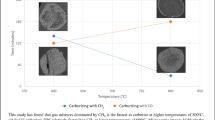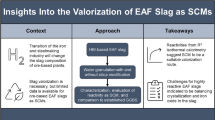Abstract
The introduction of carbon (in the form of cementite) into directly reduced iron (DRI) is vital or desired even in the wake of the transition toward fossil-free iron production technology, where iron ore pellets are reduced only by hydrogen. It is essential for the smooth and efficient melting of DRI in steelmaking operations. One way to carburize DRI in a fossil-free manner is to use bio-syngas generated from the gasification of biomass as the carburizing media. Therefore, it is necessary to understand the carburization behavior of hydrogen-reduced DRI when it is exposed to various gas compositions. Bio-syngas comprises several species, such as CH4, CO, H2, CO2 and N2, in varying proportions and can be further altered by lowering the % CO2 by gas cleaning and the % N2 by enrichment with O2, which is often available in excess in the process chain as a by-product from the electrolysis of water. Therefore, in this study, to identify the optimum thermal and gaseous atmospheres, the carburization of hydrogen-reduced DRI exposed to bio-syngas mixtures, which was varied by lowering the N2 and CO2 contents to three levels between 600 and 800 °C, was investigated. The isothermal experiments were designed with FactSage to determine the temperatures and gas compositions favorable for the formation of cementite (Fe3C) and were performed in a thermogravimetric analyser (TGA), and the samples were in the form of a single pellet. The carburized DRI was examined microscopically to determine their cementite content and distribution using an image analysis method developed in-house that was embedded with a deep learning module. It was found that eradicating N2 from the gas mix to the maximum possible extent increased the carburizing extent and rate. Although it is preferred to have CO2 in the gas mix, as it helps stabilize the cementite formed by slowing its decomposition into iron and free carbon, a CO2 quantity > approx. 7–8% significantly decreased the rate of cementite formation. Higher amounts of CO (> 35–49%) accompanied by 20–30% H2 and 14–15% CH4 in the gas mix enhanced the rate and extent of cementite formation. Additionally, it was observed that DRI exposed to temperatures of 700 °C had a uniform distribution of cementite and were relatively more stable against decomposition.
Graphical Abstract














Similar content being viewed by others
References
United Nations (2020) The Paris Agreement. https://Unfccc.int/process-and-meetings/the-paris-agreement/the-paris-agreement
WorldSteel Association (2021) Climate action: worldsteel member initiatives. https://worldsteel.org/steel-topics/environment-and-climate-change/climate-action/climate-member-initiatives/
Government of Sweden (2016) Paris climate agreement enters into force today. https://www.government.se/press-releases/2016/11/paris-climate-agreement-enters-into-force-today/. Accessed 2020
HYBRIT (2020) https://www.hybritdevelopment.com/
Pei M, Petäjäniemi M, Regnell A, Wijk O (2020) Toward a fossil free future with HYBRIT: development of iron and steelmaking technology in Sweden and Finland. Metals 10:972. https://doi.org/10.3390/met10070972
Erwee MW, Pistorius PC (2012) Nitrogen in SL/RN direct reduced iron: origin and effect on nitrogen control in EAF steelmaking. Ironmak Steelmak 39:336–341. https://doi.org/10.1179/1743281211Y.0000000076
Jess A, Depner H (1998) Reduction and carburization of iron ore in a fluidized bed by CO, H2 and CH4. Steel Res 69:77–84. https://doi.org/10.1002/srin.199801454
Geonu K, Yilmaz K, Pistorius PC (2019) Effect of Carbon Bonding State and Concentration on Melting of Direct Reduced Iron. AISTech 2019 — Proceedings of the Iron & Steel Technology Conference. Pittsburgh, USA. https://doi.org/10.33313/377/069.
Ostrovski O, Zhang G (2006) Reduction and carburization of metal oxides by methane-containing gas. AIChE J 52:300–310. https://doi.org/10.1002/aic.10628
Grabke HJ, Müller-Lorenz EM, Schneider A (2001) Carburization and metal dusting on iron. ISIJ Int 41:S1–S8. https://doi.org/10.2355/isijinternational.41.Suppl_S1
Kim G, Kacar Y, Pistorius PC (2019) Carbon bonding state has a small effect on melting of direct-reduced iron. Metall Mater Trans B 50:2508–2516. https://doi.org/10.1007/s11663-019-01691-0
Longbottom RJ, Ostrovski O, Park E (2006) Formation of cementite from titanomagnetite ore. ISIJ Int 46:641–646. https://doi.org/10.2355/isijinternational.46.641
Longbottom RJ, Ostrovski O, Zhang J, Young D (2007) Stability of cementite formed from hematite and titanomagnetite ore. Metall Mater Trans B 38:175–184. https://doi.org/10.1007/s11663-006-9005-2
Zhang J, Ostrovski O, Suzuki K (2000) Effect of temperature on cementite formation by reaction of iron ore with H2-CH4-Ar gas. Metall Mater Trans B 31:1139. https://doi.org/10.1007/s11663-000-0091-2
Iguchi Y, Sawai S, Ohiwa K (2001) Kinetics of carbide formation from reduced iron in CO-H2-H2S mixtures. Metall Mater Trans B 32:1161–1170. https://doi.org/10.1007/s11663-001-0103-x
Fruehan R (1973) The rate of carburization of iron in CO-H2 atmospheres: Part I. Effect of temperature and CO and H2 pressures. Metall Trans 4:2123–2127. https://doi.org/10.1007/BF02643276
Kazemi M, Sichen D (2016) Effect of experimental conditions on cementite formation during reduction of iron ore pellets. Metall Mater Trans B 47:3519–3526. https://doi.org/10.1007/s11663-016-0780-0
Hayashi S, Iguchi Y (1998) Production of iron carbide from iron ores in a fluidized bed. ISIJ Int 38:1053–1061. https://doi.org/10.2355/isijinternational.38.1053
Iguchi Y, Hori K, Shibata T, Hayashi S (2004) Rate of iron carbide formation from reduced iron in CO-H2-H2S mixtures under pressurized conditions. ISIJ Int 44:984–991. https://doi.org/10.2355/isijinternational.44.984
Hwang H, Chung U, Chung W, Cho Y, Jung B, Martin G (2004) Carburization of iron using CO-H2 gas mixture. Met Mater Int 10:77–82. https://doi.org/10.1007/BF03027366
Grip C, Toffolo A, Salman H, Andersson LI, Ritzen O, Tottie M, Robinnsson R, Winnikka H, Östman M, Sandberg E (2015) Forestry Meets Steel: A Technoeconomic Study of the Possible DRI Production using Biomass. http://urn.kb.se/resolve?urn=urn%3Anbn%3Ase%3Altu%3Adiva-28242
Bermudez J, Fidalgo B (2016) Production of bio-syngas and bio-hydrogen via gasification. Handb Biofuels Product. https://doi.org/10.1016/B978-0-08-100455-5.00015-1
El-Tawil AA, Björkman B, Lundgren M, Robles A, Sundqvist Ökvist L (2021) Influence of bio-coal properties on carbonization and bio-coke reactivity. Metals 11:1752. https://doi.org/10.3390/met11111752
FactSage (2020) vol. 2019, http://www.factsage.com/
Sandeep KTK, Simonsson M, Viswanathan NN, Ahmed H, Andersson C, El-Geassy AA, Björkman B (2018) Establishing a novel methodology to correlate the macroscopic and microscopic degree of sintering in magnetite pellets during induration. Steel Res Int 89:1700366. https://doi.org/10.1002/srin.201700366
Wennebro J, Wiinikka H, Molinder R, Lundgern M (2015) Producing synthesis gas from biomass gasification for direct reduction of iron. SP Energy Technology Center
Avner SH (1974) Introduction to physical metallurgy. McGraw-Hill, New York
Acknowledgements
The project members would like to thank the Swedish Energy Agency (Energimyndigheten) for funding through the HYBRIT Research Program 1. Gratitude is also extended to the Metallographic Laboratory (Metlab) of LKAB with special mention to Elin Åstrom and Lars Bohman for their support in microscopic sample preparation and image analysis. The research was carried out within the CAMM, the Centre of Advanced Mining and Metallurgy, at Luleå University of Technology.
Author information
Authors and Affiliations
Corresponding author
Ethics declarations
Conflict of interest
On behalf of all authors, the corresponding author states that there is no conflict of interest.
Additional information
The contributing editor for this article was Sharif Jahanshahi.
Publisher's Note
Springer Nature remains neutral with regard to jurisdictional claims in published maps and institutional affiliations.
Rights and permissions
About this article
Cite this article
Kumar, T.K.S., Ahmed, H., Alatalo, J. et al. Carburization Behavior of Hydrogen-Reduced DRI Using Synthetic Bio-syngas Mixtures as Fossil-Free Carbon Sources. J. Sustain. Metall. 8, 1546–1560 (2022). https://doi.org/10.1007/s40831-022-00590-0
Received:
Accepted:
Published:
Issue Date:
DOI: https://doi.org/10.1007/s40831-022-00590-0




